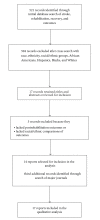Racial/Ethnic differences in poststroke rehabilitation outcomes
- PMID: 25028619
- PMCID: PMC4084586
- DOI: 10.1155/2014/950746
Racial/Ethnic differences in poststroke rehabilitation outcomes
Abstract
Background. Significant racial and ethnic disparities in stroke incidence, severity, and morbidity have been consistently reported; however, less is known about potential differences in poststroke rehabilitation outcomes. Objective. To examine racial and ethnic differences in poststroke rehabilitation outcomes. Methods. We completed an in-depth search of Medline and several major journals dedicated to publishing research articles on stroke, rehabilitation, and racial-ethnic patterns of disease over a 10-year period (2003-2012). We identified studies that reported rehabilitation outcomes and the race or ethnicity of at least two groups. Results. 17 studies involving 429,108 stroke survivors met inclusion criteria for the review. The majority (94%) of studies examined outcomes between Blacks and Whites. Of those studies examining outcomes between Blacks and Whites, 59% showed that Blacks were generally less likely to achieve equivalent functional improvement following rehabilitation. Blacks were more likely to experience lower FIM gain or change scores (range: 1-60%) and more likely to have lower efficiency scores (range: 5-16%) than Whites. Conclusions. Black stroke survivors appear to generally achieve poorer functional outcomes than White stroke survivors. Future studies are warranted to evaluate the precise magnitude of these differences, whether they go beyond chance, and the underlying contributory mechanisms.
Similar articles
-
Racial/ethnic differences in FIM scores and length of stay for underinsured patients undergoing stroke inpatient rehabilitation.Am J Phys Med Rehabil. 2006 May;85(5):415-23. doi: 10.1097/01.phm.0000214320.99729.f3. Am J Phys Med Rehabil. 2006. PMID: 16628148
-
Racial differences in poststroke rehabilitation utilization and functional outcomes.Arch Phys Med Rehabil. 2015 Jan;96(1):84-90. doi: 10.1016/j.apmr.2014.08.018. Epub 2014 Sep 16. Arch Phys Med Rehabil. 2015. PMID: 25223490
-
Race/Ethnic and Stroke Subtype Differences in Poststroke Functional Recovery After Acute Rehabilitation.Arch Phys Med Rehabil. 2021 Aug;102(8):1473-1481. doi: 10.1016/j.apmr.2021.01.090. Epub 2021 Mar 5. Arch Phys Med Rehabil. 2021. PMID: 33684363
-
Racial/ethnic differences in poststroke rehabilitation utilization in the USA.Expert Rev Cardiovasc Ther. 2009 Apr;7(4):405-10. doi: 10.1586/erc.09.6. Expert Rev Cardiovasc Ther. 2009. PMID: 19379064 Review.
-
Racial and ethnic differences in reproductive potential across the life cycle.Fertil Steril. 2010 Feb;93(3):681-90. doi: 10.1016/j.fertnstert.2009.10.047. Epub 2009 Nov 25. Fertil Steril. 2010. PMID: 19939362 Review.
Cited by
-
Molecular mechanisms underlying some major common risk factors of stroke.Heliyon. 2022 Aug 18;8(8):e10218. doi: 10.1016/j.heliyon.2022.e10218. eCollection 2022 Aug. Heliyon. 2022. PMID: 36060992 Free PMC article. Review.
-
Health Factors Associated With Development and Severity of Poststroke Dysphagia: An Epidemiological Investigation.J Am Heart Assoc. 2024 Apr 2;13(7):e033922. doi: 10.1161/JAHA.123.033922. Epub 2024 Mar 27. J Am Heart Assoc. 2024. PMID: 38533959 Free PMC article.
-
Telehealth Trials to Address Health Equity in Stroke Survivors.Stroke. 2023 Feb;54(2):396-406. doi: 10.1161/STROKEAHA.122.039566. Epub 2023 Jan 23. Stroke. 2023. PMID: 36689591 Free PMC article. Review.
-
Differences in patterns of outpatient epilepsy-specific medication initiation after acute ischemic stroke in the Medicare population.Epilepsia. 2025 Aug;66(8):2728-2742. doi: 10.1111/epi.18396. Epub 2025 Apr 4. Epilepsia. 2025. PMID: 40184019
-
The impact of ethnicity on stroke care access and patient outcomes: a New Zealand nationwide observational study.Lancet Reg Health West Pac. 2022 Jan 3;20:100358. doi: 10.1016/j.lanwpc.2021.100358. eCollection 2022 Mar. Lancet Reg Health West Pac. 2022. PMID: 35036976 Free PMC article.
References
-
- National Stroke Association, African Americans and Stroke. 2013, http://www.stroke.org/site/PageServer?pagename=AAMER.
-
- White H, Boden-Albala B, Wang C, et al. Ischemic stroke subtype incidence among whites, blacks, and Hispanics: the northern Manhattan study. Circulation. 2005;111(10):1327–1331. - PubMed
-
- Qian F, Fonarow GC, Smith EE, et al. Racial and ethnic differences in outcomes in older patients with acute ischemic stroke. Circulation: Cardiovascular Quality and Outcomes. 2013;6(3):284–292. - PubMed
Publication types
LinkOut - more resources
Full Text Sources
Other Literature Sources
Miscellaneous


